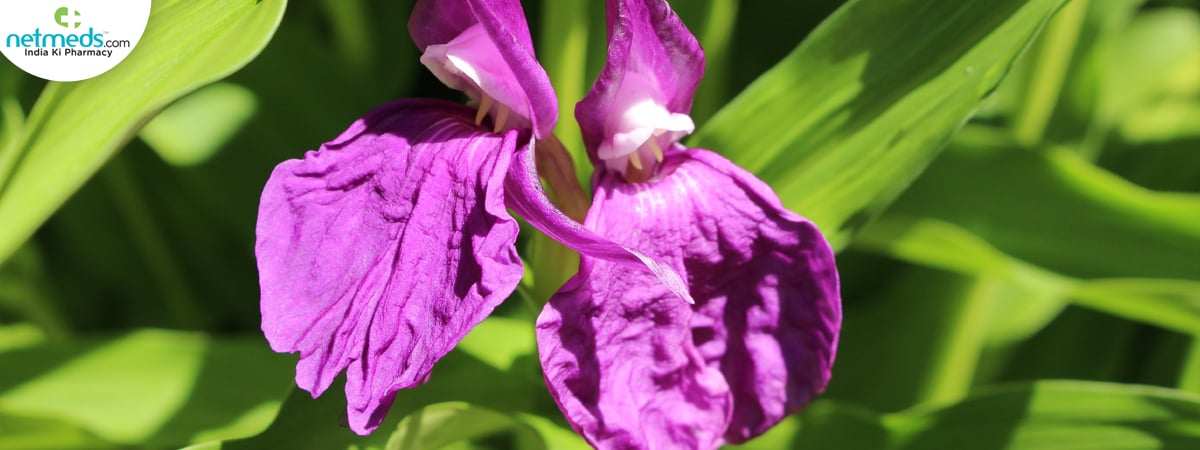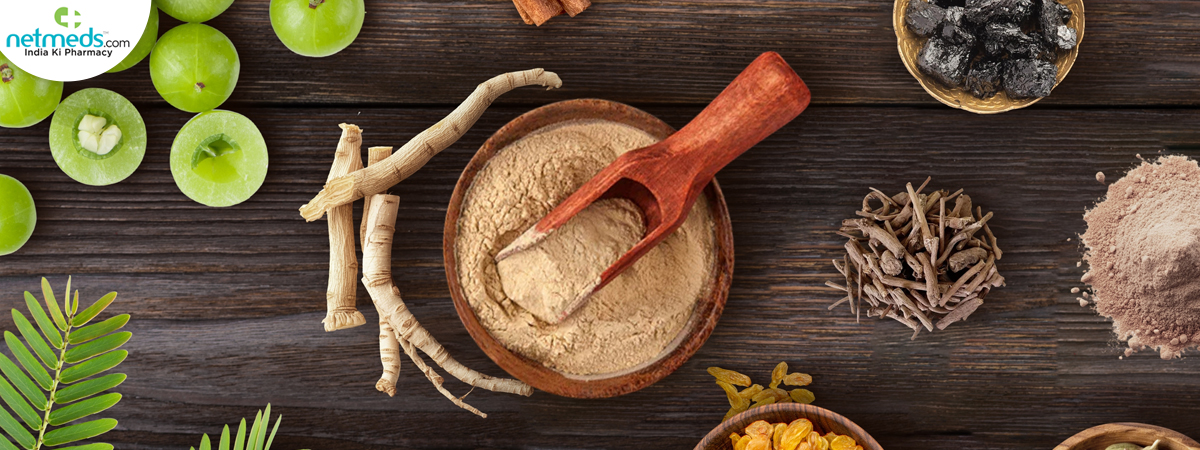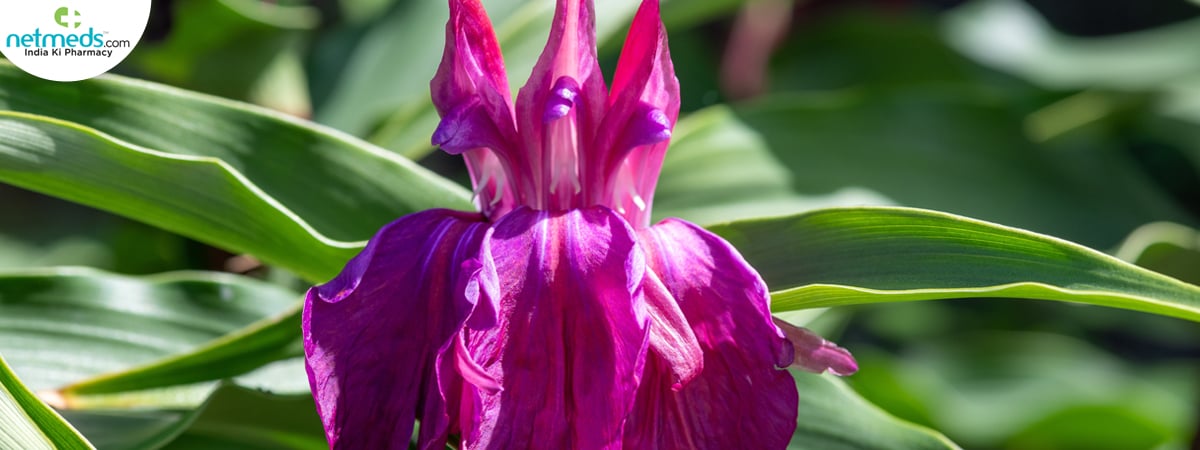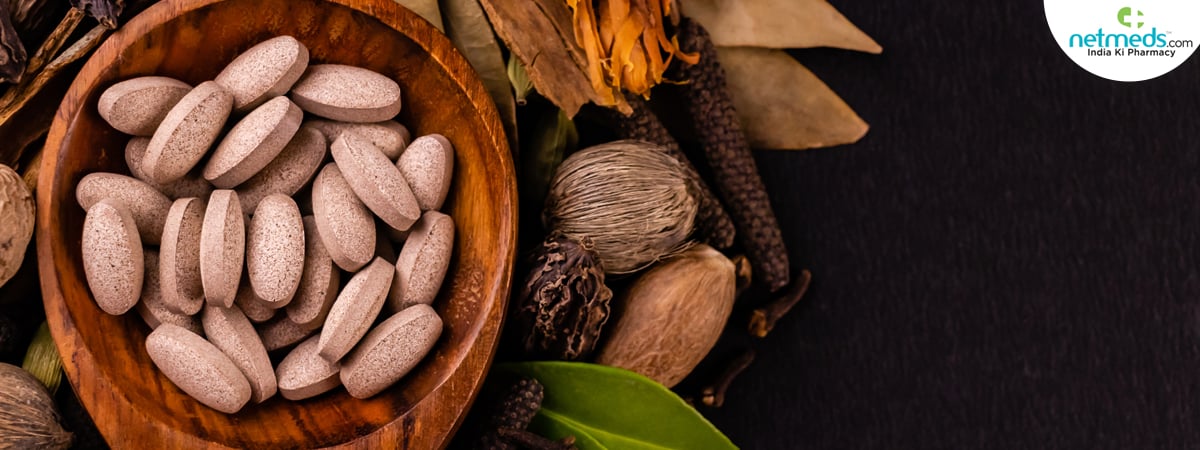If you are someone who geeks out over rare herbs and forgotten remedies, then let us introduce you to a botanical superstar Kakoli (Roscoea purpurea). While it might not enjoy the mainstream fame of turmeric or ashwagandha, this humble-looking Himalayan herb has earned a coveted spot in ancient Ayurvedic texts for its impressive healing potential. From boosting stamina to rejuvenating skin, Kakoli has long been treasured as a Rasayana, a class of Ayurvedic herbs known for promoting longevity, vitality, and youthfulness.
Be in the pink of health with our wide-range of ayurvedic supplements!
In this blog, let us find out more about the herb, its botanical description, medicinal and Ayurvedic properties, benefits, dosage, side effects and precautions.

What is Kakoli (Roscoea purpurea)?
Kakoli, scientifically known as Roscoea purpurea, is a perennial herb native to the high-altitude regions of the Himalayas, especially in India, Nepal, and Bhutan. It is one of the eight potent rejuvenative herbs in the classical Ayurvedic group called Ashtavarga, a powerful collection known for enhancing vitality and strengthening the immune system.
It is used in Ayurvedic Rasayana formulations like Chyawanprash, Jeevaniya Gana, and other tonics that promote health, strength, and longevity.
Botanical Description of Kakoli
Kakoli, scientifically known as Roscoea purpurea, belongs to the Zingiberaceae family, commonly known as the ginger family. It is also referred to by names like Kakoli and Purple Roscoea. The part of the plant used for medicinal purposes is the rhizome, which is an underground root-like stem. This herb is small and erect, typically growing up to 30–60 cm in height. It features vibrant purplish-pink flowers that make it visually striking, especially in its natural high-altitude habitat. Kakoli thrives in cool, moist alpine climates, particularly between 1,500 to 3,000 meters above sea level. The rhizome is rich in active phytoconstituents such as steroidal saponins, flavonoids, and phenolic compounds, which contribute to its potent therapeutic properties.
Kakoli Vernacular Names
Kakoli is recognized by various names across different Indian languages and regions, highlighting its historical and medicinal importance in traditional healing systems:
English: Purple Roscoea, Himalayan Ginger Lily
Hindi: Kakoli, Kakoliya
Bengali: Kakoli, Ban Halud
Tamil: Kakoli Ver, Malayalaichanghu
Telugu: Kakoli Vittulu, Vanajamudu
Kannada: Kakoli Gida, Banahalu
Malayalam: Kakoliveru, Kaattukacholam
Marathi: Kakoli, Jungli Halad
Gujarati: Kakoli, Van Haldi
These vernacular names reflect Kakoli’s regional adaptations and underscore its revered place in folk traditions and classical Ayurveda alike.

Phytochemical Profile of Kakoli (Roscoea purpurea)
Kakoli, a rare and rejuvenative herb from the Himalayas, is endowed with a wealth of bioactive compounds that contribute to its broad therapeutic efficacy. These include:
Steroidal Saponins: Known for their adaptogenic, immunomodulatory, and anti-fatigue effects; they support hormonal balance and enhance stamina.
Flavonoids: Potent antioxidants that neutralize free radicals, protect against oxidative stress, and support cardiovascular and skin health.
Phenolic Compounds: Act as strong free-radical scavengers, offering anti-aging, anti-inflammatory, and neuroprotective benefits.
Glycosides: Contribute to adaptogenic and cardiotonic effects, enhancing vitality and overall systemic resilience.
Alkaloids: Provide analgesic and anti-inflammatory actions, supporting pain relief and immune function.
Polysaccharides: Strengthen immune response and help in cellular repair and tissue regeneration.
Essential Oils: Found in small quantities, these contribute to the herb’s antimicrobial and aromatic qualities.
This diverse phytochemical makeup makes Kakoli an exceptional Rasayana herb in Ayurveda, deserving attention for its potential in modern herbal pharmacology.
Medicinal Qualities of Kakoli (Roscoea purpurea)
Kakoli has been praised in ancient Ayurvedic texts and is one of the key ingredients in the rejuvenating Ashtavarga group. Here are some of its major medicinal properties:
Rasayana (Rejuvenative): Revitalizes tissues, slows down aging, enhances vitality, and promotes longevity.
Adaptogenic: Helps the body cope with physical, emotional, and environmental stressors while restoring hormonal balance.
Aphrodisiac: Improves sexual health, enhances libido, and supports reproductive functions in both men and women.
Immunomodulatory: Boosts the immune system and strengthens the body's natural defense against infections and diseases.
Anti-inflammatory: Reduces inflammation at the cellular level, making it beneficial for chronic inflammatory disorders.
Antioxidant: Neutralizes oxidative damage, supports skin health, delays aging, and protects vital organs.
Cardioprotective: Supports heart health by improving circulation, strengthening cardiac muscles, and reducing oxidative load.
Nervine Tonic: Calms the nervous system, alleviates fatigue and anxiety, and improves cognitive functions.
Digestive Support: Aids digestion gently, enhances metabolic functions, and pacifies aggravated Pitta and Vata doshas.
Tissue Rejuvenator: Nourishes and strengthens all seven dhatus (body tissues), aiding recovery from illness, trauma, and chronic fatigue.
Together, these medicinal qualities underscore Kakoli's holistic healing potential in traditional and integrative medicine systems.
Ayurvedic Properties of Kakoli (According to Ayurveda)
In Ayurveda, Kakoli is considered a Rasayana, an herb that restores youth, vitality, and ojas (life energy). It has the following properties:
Rasa (Taste): Madhura (Sweet), Tikta (Bitter)
Guna (Quality): Snigdha (Unctuous), Laghu (Light)
Virya (Potency): Sheeta (Cooling)
Vipaka (Post-digestive effect): Madhura (Sweet)
Effect on Doshas: Balances Vata and Pitta doshas
Its therapeutic actions include tonic, adaptogenic, aphrodisiac, anti-inflammatory, antioxidant, and immunomodulatory effects.

10 Powerful Health Benefits of Kakoli (Roscoea purpurea)
Rejuvenates the Body and Mind
Kakoli is revered for its Rasayana properties, meaning it rejuvenates the entire system. It boosts cellular regeneration, supports mental clarity, and restores energy, making it ideal for those feeling drained or burnt out.
Enhances Stamina and Strength
Commonly used in formulations aimed at improving physical strength, Kakoli nourishes body tissues and promotes muscle tone. It’s a great addition for those recovering from illness or looking to improve endurance and stamina.
Also Checkout: Ayurvedic Herbs For Stamina: 5 Natural Energizers To Fight Fatigue Fast - Infographic
Supports Female Reproductive Health
Kakoli is often used in Ayurvedic formulations for female fertility and reproductive wellness. It helps regulate menstrual cycles, strengthens the uterus, and can be beneficial in managing fatigue and weakness post-pregnancy.
Boosts Male Libido and Vitality
As a natural aphrodisiac, Kakoli enhances sexual health by increasing libido, improving performance, and reducing sexual weakness in men. It also supports the healthy production of semen and testosterone.
Improves Respiratory Health
Used traditionally in the treatment of respiratory conditions, Kakoli helps soothe dry coughs, bronchitis, and asthma. Its cooling and anti-inflammatory effects ease irritated airways and support lung function.
Also Read: Respiratory Health: 5 Incredible Herbs To Boost Your Lung Power
Strengthens Immunity
The herb contains potent antioxidants and immunomodulatory compounds, which help in strengthening the body’s natural defense mechanisms. It is often prescribed in convalescence to restore immunity and ward off infections.
Promotes Healthy Skin and Hair
With its Vata-Pitta pacifying nature and regenerative properties, Kakoli nourishes the skin and improves complexion. It is also known to reduce inflammation, delay signs of aging, and promote healthy hair growth.
Also Read: The Elixir Of Youth: Proven Ayurvedic Herbs For Astounding Anti-Ageing Benefits
Supports Digestive Health
Kakoli’s light and sweet properties aid digestion without overheating the body. It enhances agni (digestive fire) while pacifying inflammation, making it beneficial in cases of gastritis, bloating, or acid reflux.
Aids in Post-Illness Recovery
After prolonged illness or surgery, Kakoli can help in restoring strength and stamina. It revitalizes all seven dhatus (body tissues) and supports overall metabolic activity.
Protects the Heart
Some Ayurvedic physicians use Kakoli in cardiac tonics, as it supports healthy circulation, strengthens heart muscles, and reduces oxidative stress on the cardiovascular system.
Also Read: Heart Health: Add These 5 Powerful Herbs For Optimal Cardiac Function

Kakoli Dosage
Kakoli (Roscoea purpurea) is a powerful Ayurvedic herb valued for its rejuvenating and adaptogenic properties. Due to its potency and rare status, it should be used under the supervision of a qualified Ayurvedic practitioner to ensure safe and effective use.
Powder (Churna):
Take 1 to 3 grams of dried Kakoli rhizome powder once or twice daily. It can be mixed with warm milk, honey, or water for enhanced absorption and palatability.
Decoction (Kashayam):
Boil 3–5 grams of Kakoli rhizome in 200 ml of water until reduced to 50 ml. Strain and consume 25–50 ml, once daily, preferably on an empty stomach or as advised.
Capsules/Extracts:
Standardized Kakoli supplements are available in capsule form, generally in 250–500 mg doses. Follow the label instructions or take as prescribed by your Ayurvedic doctor.
Medicinal Ghee (Ghrita):
Kakoli is often used in medicated ghee formulations. A typical dose is 5–10 grams once daily, usually taken with warm water or milk.
Topical Use:
While topical use is rare, powdered Kakoli may be combined with ghee or herbal oils in specialized formulations for skin rejuvenation. Always use such applications under expert guidance.
Note: Dosages may vary based on age, body constitution (Prakriti), health condition, and the intended therapeutic goal. Always consult an experienced Ayurvedic practitioner before starting Kakoli.
Side Effects of Kakoli
Kakoli is generally considered safe when taken in the correct dosage. However, overuse or improper use may result in:
Mild digestive disturbances (in rare cases)
Drowsiness or excessive cooling in individuals with a Kapha imbalance
Allergic reactions (very rare)
Precautions To Keep in Mind While Using Kakoli
Pregnant or lactating women should use Kakoli only under medical supervision.
Avoid self-medicating with Kakoli, especially in large doses or for extended periods.
People with Kapha-dominant conditions should use this herb cautiously due to its cooling and unctuous nature.
Always buy from a trusted source to ensure purity and avoid adulteration, especially since Kakoli is a rare herb.
Conclusion
Kakoli (Roscoea purpurea) may be an unsung hero in the modern wellness scene, but its value has been well documented for centuries in Ayurveda. From enhancing vitality to improving reproductive health and boosting immunity, this powerful adaptogen truly embodies the spirit of holistic healing.
So, if you are looking to enrich your Ayurvedic routine or seeking natural ways to restore health and energy, Kakoli could be the botanical treasure your body’s been waiting for.
Frequently Asked Questions
What is Kakoli used for in Ayurveda?
Kakoli is used for rejuvenation, boosting stamina, improving reproductive health, and strengthening the immune system.
Can Kakoli be taken daily?
Yes, but only in prescribed amounts and under the guidance of a qualified Ayurvedic practitioner.
Is Kakoli safe for pregnant women?
It is best to avoid using Kakoli during pregnancy unless recommended by an Ayurvedic physician.
What are the side effects of Kakoli?
When taken correctly, it is safe; overuse may cause digestive discomfort or excessive cooling.
How is Kakoli different from other Rasayana herbs?
Kakoli is one of the rare eight Ashtavarga herbs, which are considered elite rejuvenators in classical Ayurveda.
(This article is reviewed by Kalyani Krishna Chief Content Editor)
Author Profile
Soumita Basu:
Soumita Basu holds a Bachelor’s Degree in Pharmacy and is keenly interested in Ayurveda, home remedies, yoga, fitness, diagnostics, and beauty. With nearly 6 years of experience, she produces evidence-based health content, including articles, videos, and infographics, to provide valuable insights to her audience.
References:
- https://www.sciencedirect.com/science/article/abs/pii/S0731708524004849
- https://www.researchgate.net/publication/344696890_Kakoli_an_Important_Medicinal_Plant_of_Ayurveda_A_Classical_Review_Based_on_Various_Ayurvedic_Nighantu_and_Kosha
- http://impactfactor.org/PDF/IJPPR/8/IJPPR,Vol8,Issue11,Article7.pdf



 Previous
Previous